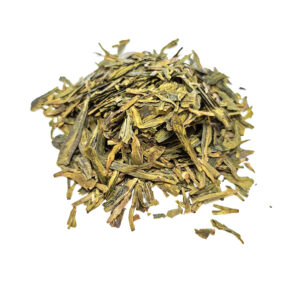Zhejiang Classic Green Tea
$29.95 – $145.95
Zhejiang classic green tea
More or less a medium grade green with an earthy, musky flavours
ideal as a starter green tea
-
Description
-
Reviews (0)
Zhejiang Province, located along the eastern coast of China, is one of the country’s most prominent tea-producing regions. When referring to “Zhejiang classic green tea,” it generally pertains to some of the most renowned green teas originating from this province.
Dragon Well (Longjing) Tea: Perhaps the most famous green tea from Zhejiang is Longjing (龙井), or Dragon Well tea. Produced near the West Lake in Hangzhou, this tea is celebrated for its beautiful flat leaf shape, jade green colour, nutty aroma, and smooth, mellow taste with notes of chestnut and toasted grass.
Anji Bai Cha: Despite the name “Bai Cha” meaning “white tea,” this is a green tea. It’s renowned for its high amino acid content, which gives it a uniquely sweet flavour. The tea bushes used for Anji Bai Cha produce pale, almost white leaves during early spring, leading to its name.
Gunpowder (Zhu Cha): This is a type of green tea where the leaves are rolled into small, round pellets resembling gunpowder. The rolling method helps retain freshness and flavour. Gunpowder tea has a slightly smoky flavour, though less so than its name might suggest.
Hui Ming: Named after a temple in Zhejiang, this tea has a long and storied history. The leaves are tightly curled and yield a bright green liquor with a fresh and mellow taste.
Qing Ding: Known as “Green Top,” this tea is traditionally produced on Tianmu Mountain in Zhejiang. It’s a high-altitude tea, which gives it a unique and refined flavour profile.
Liu An Gua Pian: While most associated with Anhui Province, some versions of this tea, known as “Melon Seed” due to its distinct leaf shape, are also produced in Zhejiang. Unlike many other green teas, the stems and veins are removed, leaving only the pure leaf which offers a rich, full-bodied flavour.
1. Processing: Zhejiang green teas, like other green teas, undergo minimal oxidation. After plucking, the leaves are typically pan-fired or steamed to halt the enzymatic oxidation process. They’re then shaped – by pressing against the sides of a hot wok (as in Dragon Well), by rolling (as in gunpowder), or by other methods depending on the specific tea variety.
2. Health Benefits: Green teas from Zhejiang, like green teas everywhere, are rich in catechins, a type of antioxidant. Regular consumption has been associated with various health benefits, from improved heart health to a faster metabolism and enhanced brain function.
3. Cultural Significance: Zhejiang’s tea culture is deeply embedded in Chinese history and literature. The province’s teas, especially Dragon Well, have been celebrated by emperors, scholars, and poets for centuries.
4. Terroir: Zhejiang’s diverse geography, from its coastal plains to mountainous regions, and its temperate climate, punctuated by a monsoon season, contribute to the diverse range of green teas it produces. Each tea reflects its specific terroir, a combination of soil, altitude, and climate conditions.
Zhejiang is a treasure trove of classic green teas, each with its own unique history, flavour profile, and cultural significance. From the iconic Dragon Well to the lesser-known but equally delightful varieties, Zhejiang’s green teas represent some of the best that China has to offer.
Only logged in customers who have purchased this product may leave a review.






There are no reviews yet.